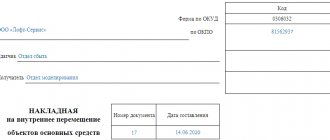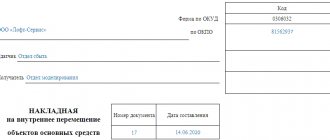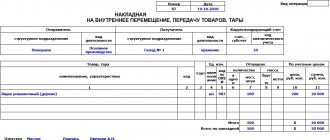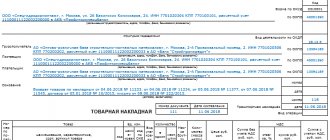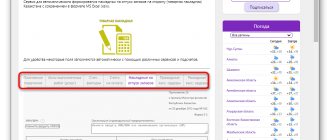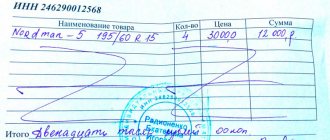The release of materials from warehouse storage is carried out in different directions: for production, for household needs, for sale. Inventory and materials can also be transferred to third party contractors free of charge.
Accounting for supply of inventory items is carried out according to the rules of PBU 5/1. The movement of inventory items, both internal and external, occurs constantly. The task of the accounting service is to accurately and fully take into account movements in order to avoid warehouse shortages.
How to write off materials when used ?
Accounting methods for inventory items
When releasing materials from the warehouse, in addition to quantitative valuation, valuation is used. In accounting, there are several methods for calculating estimated indicators:
- At average cost. When applying this method, first the cost of a certain group of material (or type) at the beginning of the month is added to the cost of received inventory items. The quantity by group or type is also summed up. By dividing the first amount by the second, the average cost of a unit of inventory is determined. Next, the number of units written off per month is multiplied by this average cost and the amount to be written off is obtained. This is how materials that are similar in properties and usage characteristics are written off.
- FIFO. This method assumes that inventory items are used sequentially, in the order in which they are received at the warehouse. Next, the materials that were the first to be transferred, for example, to production, are valued at the cost of the first goods and materials received at the warehouse, taking into account their balance in the warehouse: first, the quantity is written off at the cost of the balance, then the remaining unwritten quantity is written off at the cost of the first batch, then, if necessary, the second and etc. The remaining materials are assessed at the cost of the last received batch. FIFO is used when there are relatively stable prices for inventory items.
- Based on unit cost of inventory items. The method is used to account for particularly valuable items or hazardous substances and consists of recording each receipt of such materials. Upon release, the same price applies as upon arrival at the warehouse. The method is also used for small volumes of warehouse operations.
What documents are used to document the internal movement and release of materials into production ?
the write-off of construction materials in accounting ?
On a note! The LIFO method is the opposite in meaning to the method, i.e.
according to the cost of the last received batch, then the penultimate one, etc. FIFO has lost its importance today, since its use is justified in conditions of high inflation.
Documentation in stock
Lists of warehouse documents used by Russian enterprises are mostly unified. This is due to the fact that most of these forms must comply with the requirements of Law No. 402-FZ on Accounting (LINK). The unified ones are just right, and there is no need to look for an alternative to them.
It can be noted that each warehouse document (a group of documents of the same type), as a rule, relates to a specific warehouse operation (or sequence of operations). Thus, in Russian warehouses they use:
- When documenting the receipt of goods :
- invoice from the supplier (the goods are received on its basis);
- receipt invoice - prepared by the business entity itself (used to register the received goods);
- consignment note - drawn up according to the unified form No. 1-T (used to document the acceptance and delivery of goods delivered on a particular vehicle);
- receipt order in form M-4 (used to record goods received directly to the warehouse and is issued, as a rule, on the basis of invoices);
- certificate of acceptance of materials in form M-7 (used in case of discrepancies in actual and declared delivery characteristics);
- acceptance certificate in the TORG-1 (used after a complete check of the declared characteristics of the delivery and certification of its compliance with the actual one);
- act of discrepancies in the TORG-2 (used if there were discrepancies).
- When documenting product placement :
- product label in the TORG-11 (reflects the main characteristics of the product and its quantity, needed when compiling inventory lists);
- materials accounting card in form M-17 (used to record the receipt and disposal of materials relative to their location).
- When documenting the movement of goods :
- invoice in form M-11 (used when documenting the movement of goods within various divisions of the organization);
- invoice in the TORG-13 (used when moving goods between the higher and parent structures of a holding or other corporate structure subordinating one business entity to another).
- When documenting the release of goods from the warehouse :
- invoice in form M-15 (used when sending goods to another organization or when selling them);
- invoice in the form TORG-12 (used when selling goods directly from the warehouse);
- act of write-off in form TORG-16 (applied if the product loses its consumer qualities and is subject to write-off).
[adsp-pro-6]
An example of a practical scenario for using the specified documentation:
- The forwarder, who has delivered the goods from the supplier, gives the shipping documents to the person working at the receiving organization.
- A person from the receiving organization looks at these documents, draws up the necessary invoices, and registers them in the prescribed manner.
- The goods are moved to the warehouse, and a receipt is issued for them.
- An inventory of placed goods is periodically carried out by the inventory commission (using various inventories).
- Goods are moved from warehouse to production - and this is certified by the TORG-12 invoice.
The main documents indicated above (of course, the above list is not exhaustive) documents, therefore, reflect the fact of certain operations with goods as part of their movement in the warehouse (and in relation to the warehouse). These actions are obviously performed by a person (or a machine, if the warehouse is robotic - but it is also programmed by a person, and he ensures that the machine reproduces typical human actions). These actions (as well as the procedures for documenting them) take some time and require certain labor investments.
Video - how an individual entrepreneur can maintain warehouse records in the My Business service (LINK):
Accordingly, it is in the interests of an economic entity to minimize time and labor costs associated with:
- with the implementation of the operations themselves with goods within the warehouse;
- with documentation of these transactions in various accounting documents (as well as the practical use of such documents subsequently).
Automation of warehouse accounting contributes to the solution of these two problems. That is, the use of programs that:
- speed up and optimize the procedure for filling out and using accounting documents;
- determine (help determine) the best algorithms for carrying out warehouse operations (which warehouse workers are subsequently recommended or instructed to follow).
Obviously, the larger the enterprise, the more in demand there will be optimization - in at least two of these areas. And, accordingly, automation using special computer programs.
There are a huge number of these on the Russian (as well as on the world) market. Let's try to highlight the key criteria that you can focus on when choosing such solutions.
Documentation
An organization can use standardized forms of documentation to record the disposal of materials from a warehouse, or it can use independently developed forms. Their presence is reflected in the accounting policies.
Unified forms of primary documents for the release of goods and materials for production needs are:
- limit-fence card (according to f. M-8);
- demand-invoice (according to Form M-11);
- invoice (form M-15);
- invoice for internal movement (form TORG-13 or a form developed by the organization).
All forms are standard and can be used regardless of the industry.
Documents confirming other disposals from the warehouse (for example, gratuitous transfer, write-off of shortages, damage, theft) can serve as various acts for the write-off of MC, signed by members of a commission created in the organization, TTN, applications for leave to the outside.
The sale of goods and materials is formalized taking into account the applicable taxation system, the specifics of current legislative acts, etc. The release to buyers, legal entities or individuals, is carried out on the basis of contracts with them.
An invoice is issued for the release of goods and materials to the third party, and, if necessary, an invoice and other documents for sale. Transportation of goods and materials from the warehouse is issued by TTN.
Not with papers alone
Warehouse accounting of goods in trade and production is not limited to only the mentioned documents. Additionally, a materials accounting book is also used. This is common in cases where the movement of goods is active. Sometimes replacements in the form of warehouse cards are also possible. They are filled by the storekeeper in cases where it is necessary to work in a large warehouse.
Also, do not forget about programs. Warehouse accounting of goods using computer technology allows you to organize an adequate analytical and synthetic electronic document, easy for orientation and transfer to other departments.
Also, competent selection of employees plays an important role in warehouse management. They must have appropriate qualifications. Automation of work processes plays a significant role in this matter. So, if such a provision was successfully implemented, then machine programs will be able to perform part of the activities. Essentially, they are used in the same way as maps and books. But working with them is carried out much more quickly and efficiently.
Account correspondence
Postings are generated depending on the purpose of the release of materials from the warehouse.
For production and management purposes:
- Dt 20, 23, 29 Kt 10 - materials were transferred to the main, auxiliary, and service production.
- Dt 25, 26 Kt 10 – materials were transferred for general production and general economic needs.
- Dt 10 Kt 10 – internal movement of goods and materials from the warehouse to the storerooms of departments, workshops, and production facilities.
Other write-offs:
- Dt 94 Kt 10 - materials were written off based on the commission’s report.
- Dt 20, 23, 29, 25, 26 Kt 94 - amounts are attributed to the expenses of production - main, auxiliary, servicing, maintenance and experimental work (these entries reflect disposal due to shortages, losses, spoilage within the limits of natural loss norms).
- Dt 73/2 Kt 94 - the shortage is attributed to the guilty persons (above the natural loss norms).
- Dt 50, 70 Kt 73/2 - the guilty person repaid the debt by depositing the amount into the cash register or deducting it from wages.
- Dt 91/2 Kt 68 – VAT, previously presented for deduction on goods and materials, was restored for shortages in excess of the norms of natural loss.
- Dt 91/2 Kt 94 - if inventory items are lost in excess of the norms of natural loss, but there is no possibility of recovering the cost from the culprits (the culprit has not been identified or has been acquitted in court).
The gratuitous transfer of goods and materials is attributed to Dt 91/2 , and loss due to force majeure, natural disasters - to Dt 99, with Kt 10. In this case, it is necessary to restore VAT with a posting similar to the one above.
Implementation:
- Dt 91/2 Kt 10 – disposal from the warehouse.
- Dt 62 Kt 90/1 (with VAT), Dt 91/2 Kt 68 – the sale of inventory items and VAT on them is recorded.
- Dt 50.51 Kt 62 - the buyer paid for the materials.
If there is an advance payment, then:
- Dt 50, 51 Kt 62/2 – the prepayment amount is reflected.
- Dt 76 Kt 68 – VAT is charged on prepayment.
- Dt 91/2 Kt 10 – disposal from the warehouse.
- Dt 62/1 Kt 91/1, (with VAT), Dt 91/2 Kt 68 – the sale of inventory items and VAT on them is recorded.
- Dt 62/1 Kt 62/2 – offset of prepayment for inventory items.
- Dt 68 Kt 76 – crediting VAT on the repaid prepayment amount.
Operating procedure
First, materially responsible persons (MROs) are determined. Inventory inventory and reporting should always be carried out by those who have the appropriate authority and trust from management.
It is also necessary to document the processing of incoming papers. After all, they are the ones used to check the registered goods. Work rules and regulations should also be well explained. For example, you cannot release products from a warehouse if the list of documents provided is not complete. To avoid temptations, responsibility for this matter should be assigned to the manager so that he can monitor the process efficiently.
He, most often, is the financially responsible person. Also, when touching on issues of third-party departments, namely accounting audits, it is necessary to establish the authenticity of the documentation provided. In addition, it is also necessary to pay attention to the correctness of filling out reports and the consistency of the data. If errors are found, the accountant must make corrections and report this to the storekeeper.
Tax accounting
The write-off of materials for production is involved in the formation of costs for NU purposes (Article 318-1 of the Tax Code of the Russian Federation).
If materials from the warehouse are not immediately written off for production, but are transferred to responsible persons in workshops or departments (their internal movement occurs), then there is no need to rush to write them off to production accounts. This may lead to an overestimation of the costs of the current period and raise questions from officials of the fiscal authority during the next audit, if the basis of the NU is accounting indicators.
In this case, it is also advisable to draw up a statement of expenditure of goods and materials, which directly reflects the expenditure in production - as a justification for costs for the Federal Tax Service.
An act may not be drawn up if the limit card or other vacation documents indicate that inventory items will be used immediately (for example, writing instruments in the accounting department).
However, many organizations use an approach in which they always draw up the specified document, regardless of whether the purpose of the vacation is indicated in the primary vacation documents or not. It is recognized as the safest from the point of view of tax audits and claims from Federal Tax Service officials.
The gratuitous transfer of goods and materials is subject to value added tax under Art. 146-1 Tax Code of the Russian Federation.
Results
Inventory and materials are written off from the warehouse at a cost calculated depending on the method used: FIFO, at unit cost or at average cost.
Postings are formed depending on the nature of the movement of materials - internal or external.
For the purposes of NU, it is advisable to document the consumption of materials with a certificate of consumption of goods and materials. The use of this document excludes overestimation of costs for materials in calculations based on the results of the month, and, consequently, claims from the Federal Tax Service.
For accounting purposes, write-offs are recorded using both unified forms of primary documents and those developed by the organization independently.
Organization of warehouse work. Description. BPMN diagrams are included
The barcode was invented in 1951 and, it would seem, has already become firmly established in our lives, however, as my practice shows, many users do not know what it is, even many IT specialists do not know what a barcode scanner and data collection terminal are . And it seems that all this is difficult to understand and implement, but in fact it is quite simple. And one of the goals of this article is to show how simple barcoding is, to clarify the logic and sequence of operations in an automated warehouse. This article does not pretend to be true: in some projects the issue of automation is solved differently than the option given in the article. My company had about 30 such projects where it was necessary to bring the warehouse to an efficient, operational state. And I developed a work scheme that became for me the standard for warehouse automation. On the one hand, it is simple, on the other, it meets the basic requirements.
The warehouse operation scheme presented in the article is scalable, but the essence remains the same in any case. This work scheme is suitable for both reseller companies and manufacturing companies that have a warehouse and keep records of goods or materials.
We will talk about warehouse accounting using special equipment, software and hardware. I will tell you what devices are used, at what point, and what to do in certain situations.
This article is intended primarily for IT specialists, programmers and those who have at least some technical skills. Firstly, the article uses terms that are often not clear to ordinary users. Secondly, there are also BPMN notations describing business processes that will be understandable to a specialist, but not to the user. In addition, recently I was approached three or four times by IT specialists who opened their own stores or advised their clients. If you are going to open your own business that requires a warehouse, or are providing consulting on the implementation of programs and equipment, this article will be useful to you.
So, let's begin.
Why do you need warehouse automation?
Nowadays, clients quite often contact my company regarding the implementation of a CRM system, increasing sales, optimizing processes, etc.
But at the analysis stage, I, as a rule, also look at how the warehouse is structured (usually companies always have stock). And if I see any “failures” in the operation of the warehouse, I certainly inform the company’s management.
What is the point of implementing a CRM system and a sales increase system if product accounting is not maintained correctly? What if a client with whom you worked so carefully, applying innovations, ends up ordering a product from you that is in short supply or mismatched, and is out of stock? It turns out that you did all the work in vain?
Therefore, I always recommend first setting up a system for storing and accounting for goods and automating the work of the warehouse.
Typically, the warehouse of small and medium-sized enterprises is at the most primitive level. Warehouse accounting is carried out manually. The accuracy of the accounting leaves much to be desired. Based on my experience, I will say that manual warehouse accounting is much more expensive for an enterprise than its automation. With the manual method of collecting and entering data, the information that is needed often turns out to be unreliable. And an increase in the cost of servicing a product leads to an increase in the cost of the product itself.
Warehouse automation is a relatively simple technology, the implementation of which does not require expensive equipment or software. Thus, automation, if not directly affecting the increase in profits and sales volumes, certainly reduces the current costs of the enterprise.
Product barcoding
In accounting systems, it is mandatory to enter data on item barcodes. Otherwise, your accounting system will not recognize the goods, and you will not receive full accounting. When filling out information about a new item, there are two options for generating a barcode:
- entering a barcode using a scanner - this option is relevant for companies engaged in sales upon receipt of goods that have their own barcode
- automatic generation of a barcode in the accounting system - this option is relevant for manufacturing companies and reseller companies if the goods were received from the supplier without a barcode
Equipment for warehouse accounting
To automate warehouse operations, special equipment is required. You will need:
- barcode scanners for receiving, assembling and shipping goods;
- data collection terminals for inventory;
- label printers for printing, if necessary, your own product labeling
Let's take a closer look at each of these types of equipment.
1. Barcode scanner
A barcode scanner is a compact device whose main function is to read information from a product label and transmit it to the accounting system. A barcode scanner is used when assembling goods, upon receipt of goods, and when selling goods to a client.
Scanners come in different technical characteristics: single-plane, multi-plane, etc. They differ in quality, speed, reading range and other indicators.
Barcode scanners come in wired and wireless varieties. I recommend using wireless ones so as not to limit the employee’s mobility and not be tied to a location. Yes, they cost several times more, but they are very convenient.
2. Data collection terminal
Data collection terminals are a specialized device that is a laptop computer with a built-in barcode scanner.
The terminal is intended primarily for the quick collection, processing and transmission of information about goods during inventory, but can also be used when goods arrive and goods are assembled for shipment to the client.
The data collection terminal has a scanning beam; a monitor on which we can see which product has been scanned; and a button panel for entering information about the quantity of goods and for executing various commands.
Using TSD, you can either scan an entire product in a row, or read the barcode of an individual item and manually enter the quantity of this product.
The terminal, unlike a scanner, not only reads the barcode, but also accumulates information about the scanned barcodes in its memory. Naturally, there are more expensive devices that can communicate with the database and provide information about the balance of goods, etc. But we are considering the simplest version of TSD when we just need to take inventory.
TSDs are different, their cost varies from 25 thousand rubles to exorbitant figures (I saw TSDs for 250 thousand). The effectiveness of TSD in this case does not depend on price. Which TSD do I recommend using? I recommend the simplest one, which performs scanning, storing and transmitting data to the accounting system. All new-fangled Android systems, with a color display and other advanced functionality, require qualified specialists, thoughtful work with this equipment and good software. Yes, such functions are not needed, since they do not affect the final result. Therefore, the simpler the better.
Also, when purchasing a TSD, you need components such as a stand and a spare battery. TSD is the type of equipment that is quickly discontinued. You bought it, and then you may not find components for it, and you will either have to look for them or buy a new one. Therefore, I recommend stocking up on batteries immediately.
Why do you need a stand? It is connected to the accounting system itself, through which data is transferred from the TSD to the system. In addition, the equipment usually does not include a USB cable to connect the stand to a computer; this must also be purchased.
Another important nuance that must be taken into account when purchasing a TSD: you can buy one or two stands for four or five terminals. Why? The terminal itself is constantly used during inventory, but the stand is used for a short period of time to upload and download data from your system to the data terminal in your accounting system. You can wait, since the upload itself takes 10-15 seconds, depending on the speed of the terminal. I recommend that clients purchase 2 stands and 5 TSDs for one medium-sized warehouse for quick inventory.
In addition, TSD can be used upon admission or sale. You can scan all received goods with the terminal and load the data into the receipt document in the accounting system.
3. Label printer
A label printer is a device that prints a barcode image onto a label. The accounting system generates a label, which is then printed on a printer.
Labels with barcodes must be printed, as I wrote above, on products that do not have a barcode. This happens if you are the manufacturer of the product, or you received a product from the supplier that does not have a barcode.
Which label printer should I buy? I recommend buying not the most expensive, but not the cheapest label printer.
What you should pay attention to when purchasing:
- performance
- label width. If you have a large product and want to print a large label, then you should choose a printer that can print that width.
- conditions in which the device can operate. Quite often it happens that warehouses are located in an unheated room, and equipment is purchased for an office; naturally, it will quickly fail due to temperature changes, humidity, etc. Therefore, if you have an unheated warehouse, always take into account the conditions in which it can operate device.
It is necessary to say a few words about the labels themselves. Labels are specialized paper for marking a product, with the ability to apply graphic information, and not just a barcode. Labels can be of different sizes and made of different materials. The sizes are very different and there is no point in describing them. I will just focus on the material - there are two types:
- thermal transfer labels - printing is only possible using a mostly black ribbon
- thermal labels - printing on thermal labels is carried out by directly heating selected points of a moving label with the thermal print head of a printer or scale
The article would not be complete if I did not talk about the cost of equipment. Yes, there are different types of equipment on the market; their prices vary greatly, but I will give a list of the equipment I chose for a real project.
| No. | Name | Price | Qty | Sum |
| 1 | Citizen CL-S 621 Thermal Transfer Label Printer (Black) | 33014 | 1 | 33014 |
| 2 | Self-adhesive label tape 30x20 (2000 pcs.) semi-gloss | 76 | 2 | 152 |
| 3 | BlueTooth laser barcode scanner Honeywell/Metrologic 1202g, Voyager, BT, USB, with stand (black) | 27411 | 2 | 54822 |
| 4 | USB interface cable (AB) | 242 | 1 | 242 |
| 5 | Terminal OPH-1005 (assembled) 4Mb flash, 64Mb RAM | 38293 | 2 | 76586 |
| Total: | 164816 | |||
Now that the goods have been barcoded, data on the correspondence of the nomenclature and barcode have been entered into the accounting system, equipment has been purchased, we can conduct automated warehouse operations. Let's take a closer look at how this happens.
Automation of warehouse processes
Conventionally, the work of a warehouse can be divided into three processes:
- Receipt of goods
- includes the following operations: capitalization of surplus, receipt of goods from the supplier, receipt of goods from production. - Storage and accounting of goods
- involves conducting inventories of goods, moving goods between warehouses and premises. - Issue of goods
- includes various operations of spending goods: write-off for internal needs, write-off of damaged goods, shipment to the client.
Let us consider in order what work happens in the warehouse during each of these processes using the example of specific operations. For ease of perception for you and your clients, at the beginning of each of the three sections I provide a description of business processes in BPMN 2.0 notation
Receipt of goods from the supplier.
How does the operation of receiving goods from a supplier take place?
- We create an order for the supplier, in which we indicate the product we need.
- The supplier delivers the goods.
- We read product barcodes one by one with a scanner and enter them into the database in the Goods Receipt document.
The question immediately arises: what to do if the goods arrived without a barcode?
We have already talked about this above, but now we will consider the procedure itself in detail. If the product arrives without a barcode, then there are two scenarios:
- If we have time and we know which goods will not have a barcode, we can prepare in advance or print out the required number of labels during reception, stick them on the goods, and then receive them into the warehouse by scanning.
- If we quickly need to receive goods in order to have information about balances in the database and immediately start reserving goods for customers, we receive goods by quantity, but without going through a scanner. That is, employees count the goods and manually enter data into the accounting system.
Once the document of goods receipt is posted in the system, employees can easily barcode the goods: print out labels with barcodes and stick them on the goods.
If the products are expensive, I do not recommend using the second option for receiving the goods. Still, in this case, you first need to barcode the product, accept it, and then start selling it.
We must remember the rule: if the goods arrived without a barcode, if we have little time and the goods are not very valuable, we can first capitalize them by quantity, without running them through a barcode scanner, and then barcode them and stick labels.
There is one useful trick when applying barcode labels to products. It is very simple, but makes the job much easier:
If you place an order with a supplier and know how much of the product will arrive, you print the labels in advance. It happens that either the entire product is not barcoded, or you know which product will not have a barcode - you generate barcodes for such products in advance in the accounting system and print out all the labels for future goods. The number of labels must match the quantity of the expected product.
Then, when the goods arrive from the supplier, you can simply stick the labels on without counting them. If there are no labels or unpasted goods left, it means that the quantity of goods corresponds to what you ordered. If there are extra labels left (this happens), it means the goods were not delivered. If there are not enough labels, it means that they brought a surplus or there is some kind of mismatch (perhaps they put a barcode on the wrong product). In this case, you need to immediately find out where you made a mistake, or what the supplier did not deliver.
So, to receive goods from a supplier or any other receipt, you need a barcode scanner and a label printer. You can also make receipts using a data collection terminal: we read all the barcodes with the terminal, and then load all the information at once or in parts into the goods receipt document in the accounting system.
After the product is labeled, you lay it out. I won’t talk about targeted storage, when your warehouse is divided into sections, and you put a certain product in a certain section and mark it in the system. Whether or not to use an address warehouse is up to everyone to decide for themselves. But I do not recommend using it in small and medium-sized enterprises, since employees begin to make mistakes, they cannot correctly calculate the area and volume of their warehouse and similar things. Therefore, this article will not consider such options as address storage, serial accounting and the like. This is scaling, increasing the complexity of the system, but this does not affect the essence of the work.
After we have accepted the goods, they are stored with us, we must control the goods, keep records of them, do the so-called inventory and, if necessary, register the movement of goods.
Storage and accounting of goods in a warehouse
Storage and accounting of goods involves conducting inventories and moving goods between warehouses and premises. The movement of goods occurs by reading barcodes - I will not go into detail here. The Transfer document represents the simultaneous release of goods from one source warehouse and arrival at the receiving warehouse. You open the Item Transfer document and scan the required item into it.
Let's take a closer look at inventory. How does it happen? What equipment is needed for this?
Inventory is checking the availability of goods on a certain date by comparing actual data with data from the accounting system.
From my experience I will say that it is wrong to do inventory on your own. Many companies carry out inventory on their own, arguing that their employees know the product very well, unlike third-party specialists. But this is wrong, since it turns out that the warehouse worker is checking himself.
Ideally, third-party companies (auditors or 1C-nicknames) will be involved to carry out the inventory, or if this is not possible, involve employees of your own company, but from other departments not related to work in the warehouse. Why is this necessary? Because, I repeat, it is impossible for a person to check himself.
There have been cases when taking inventory (especially if it was the first inventory) was a reason to write off all your shortcomings, theft, etc. and so on. Especially if a person works for a long time. If, according to the results of the inventory, everything comes together, this should arouse suspicion in you; most likely, this is not a clean matter; there is an obvious deception of the system by an employee.
I had a case where the warehouseman “found” the goods after identifying shortages as a result of inventory. It looked extremely suspicious.
Let me also remind you that inventory should be carried out on weekends or after hours to avoid movement of goods. Many companies neglect this, and then look for where the shortage came from.
How is inventory taken? An employee or several employees (if there are several employees, the warehouse is divided into sections) read the goods on the shelves one by one, using a data collection terminal. Each employee goes and scans the goods that he comes across in his section. Then the TSD is installed on the stand and the data is loaded into the accounting system.
Information from the TSD comes in the form of a document Inventory of goods or Recalculation of goods with information about which goods were scanned during this work. Then you need to delete the data from the terminal, after which you can scan the next portion of the data until the entire product has been scanned.
What nuances need to be taken into account when automated inventory of goods? If you scan an item in several passes, there is the following problem: when loading data from the terminal into the accounting system, the previous data from the Inventory document is deleted.
What do we usually do in such cases? Several Data Inventory documents are created, recording who scanned and which rack. Then we take and combine data from several documents into one by copying.
What should the system do next when we have all the data in one document? The system compares the results of the Inventory document with accounting data and provides information about surpluses and shortages. In order for the system to have up-to-date information about the balance of goods in warehouses, based on the inventory results, you must do the following:
- write off shortages
- capitalize surplus
Then, the person financially responsible for the warehouse may be fined for the difference between write-off and capitalization.
To summarize, during an inventory the following actions are carried out:
- scanning goods
- load this data into the Inventory document,
- the system automatically compares accounting data with actual data and provides us with information about the need to create Write-off and/or Receipt documents.
Issue of goods
Now consider the option of shipping goods to the client. Typically, the scheme for selling goods to a client looks like this:
- Sales manager placing a customer order
- After payment for the goods (or meringue, if the company sells the goods on credit), the manager draws up a document for the sale of the goods
- the warehouse collects and releases goods ordered by the client
But here it is necessary to understand the problems of Russian discipline.
For example, you have 50 units of goods in your database, and there are 49 of them in your warehouse. If we create a sale and carry it out, and only then collect the goods, conflicts may arise with a client who has already paid for 50 units and was expecting exactly 50. And when In this work scheme, the warehouseman informs the manager about the shortage of goods after the fact.
How can this be solved? I recommend implementing a product assembly procedure between placing a customer order and completing the sale:
- The manager reserves goods according to the client's order
- the manager gives the warehouse a task to collect the order
- Based on the order, the warehouse draws up the Order Assembly document, where it provides the necessary data about the goods assembled according to the order.
The product assembly document consists of information about what needs to be assembled and how much has already been assembled.
A warehouse worker collects goods, scans them, if the goods are scanned, the data in the collected goods column increases. If we scanned more than the required quantity, the system displays a list of extra items. If we scanned a smaller quantity, we will not be able to close the order until all the goods are collected. If in an assembly the quantity of collected goods coincides with the quantity to be assembled, sales of goods and services are created on the basis of this assembly.
If there is not enough product, the manager is informed about this, the manager already contacts the client about the order, but this is a different business process.
Why is product assembly necessary? If we immediately create an implementation, this is wrong, because then our financial obligations to the client arise. But in fact, until we see all the goods in stock according to the customer's order, until we have collected it, we cannot tell the buyer that the goods are actually in stock.
You can complete the assembly of goods not only using a scanner, but also using a data collection terminal. In this case, all assembled goods are scanned at once, and the data is loaded into the Product Assembly document.
The question often arises at enterprises: What to do with weighted goods that we sell individually?
It happens that goods are recorded by weight, but sold individually. For example, bolts. Bolts come in kilograms, but you sell them by the piece. How to be here? Very simple. The system sets up two units of measurement for the item - pcs and kg, and indicates the coefficient of how many pieces are contained in a kilogram. When selling and assembling an item, an employee scans the barcode of that item and enters the quantity of the item being sold. At the same time, labels with barcodes do not need to be stuck on each unit of goods. The warehouseman has a sheet of paper with barcodes of goods, on which a barcode cannot be pasted; he scans and drives in the number of bolts.
When writing off, the quantity is written off both in pieces and in kilograms. Then the inventory is carried out by kilograms, the goods are weighed, and the actual weight is checked against the accounting weight. Thanks to the coefficient, you can always know how many pieces are contained in a kilogram, how much one piece weighs. And if 50 kg of bolts arrived, and 1000 pieces of 50 grams were sold, we should have a quantity left of 0. If there is nothing left, then everything is in order: 50 kg of bolts arrived, 50 kg went out.
Conclusion
I hope the information provided will be enough to design and automate the operation of a warehouse at your enterprise or for your client.
Basic moments
So, warehouse accounting of goods in wholesale trade and industry is carried out taking into account three main factors:
- First of all, maintaining all documentation should be aimed at confirming the movement of commodity units. The reliability of the data provided in them determines whether the enterprise will be profitable or not.
- Then it is important to ensure that you have the necessary equipment. It should be selected and installed so that the goods can be stored in such a way that they do not deteriorate, are easily loaded and removed, and, if necessary, can be checked without problems during accounting.
- And finally: if there are several warehouses, it is necessary to ensure their interaction in order to adequately support the production or sales process. In addition, it is necessary to estimate the amount of work. It may also be that one person is not enough to run a warehouse.
How to arrange the completion/disassembly of items
Document titled “Item configuration”
can be used both for operations for completing items and for operations for disassembling items.
When creating a new document, select the type of operation in the window of the same name:
When filling out the header of the document, we indicate the following data: information about the warehouse, name, quantity and account of the kit.
To reflect the operation “Complete”
fill out the list of components of the kit in the tabular part of the document. Automatic completion of the list of kit components is possible according to a previously created specification. Otherwise, components can be entered into the table manually.
When selecting the “Disassembly”
the tabular part of the document will be changed. In addition to information about the components, their quantity and accounting account, it is necessary to fill in the “Share of cost” field, the purpose of which is to indicate in what shares the cost of the kit is distributed between its components.
Printable forms of the document are available by clicking the “Item Completion” button
and depending on the type of operation, they are the documents “Assembly of items” or “Unassembly of items”:
In the following articles we will continue to talk about registration of warehouse operations and reflection of inventory results (article on inventory)
in the configuration “1C: Enterprise Accounting”
